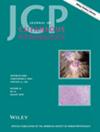Fusion-driven cutaneous and superficial mesenchymal and adnexal tumors—A clinicopathologic and molecular study of 15 cases, including a novel case of ACTB::ZMIZ2-rearranged adnexal carcinoma
Abstract
Background
While the list of fusion-driven soft tissue neoplasms is expanding rapidly, their importance among cutaneous and superficial mesenchymal and adnexal neoplasms remains poorly understood. This challenge is especially evident in cases with ambiguous histopathology that are difficult to classify based on morphology.
Aims
Our goal was to investigate the benefits of next-generation sequencing in diagnosing complex cutaneous neoplasms.
Materials & Methods
Departmental archives were searched for fusion-driven cutaneous neoplasms. Slides were retrieved and clinical information including follow-up was obtained.
Results
Fifteen cases occurred in eight female and seven male patients, with a median age of 26 years (range: 1–83) at diagnosis. Tumors involved the extremities (9), scalp (5), and head and neck (1). Predominant features included myoepithelial (5), nested spindled with clear cytoplasm (2), atypical adnexal/squamoid (2), small round blue cell (2), cellular spindled (3), and fibrohistiocytic morphology (1). Most frequently encountered fusions involved EWSR1 (6) fused to ERG (1), FLI1 (1), CREB1 (2), CREM (1), PBX3 (1), followed by PLAG1 (4) with LIFR (2), TRPS1 (1) and CHCHD7. Additional fusions encountered were YAP1::NUTM1, EML4::ALK, SS18::SSX1 (2), and a novel fusion: ACTB::ZMIZ2. Integration of histologic features and molecular findings led to final diagnoses of primary cutaneous Ewing sarcoma (2), soft tissue myoepithelioma (4), cutaneous syncytial myoepithelioma (1), cutaneous adnexal carcinoma (1), porocarcinoma (1), inflammatory myofibroblastic tumor (1), synovial sarcoma (2), clear cell sarcoma (2), and angiomatoid fibrous histiocytoma (1).
Discussion and conclusion
Our results show that fusion testing can be a helpful diagnostic tool, especially in cases with unusual or uncommon morphology in superficial sites. Furthermore, it can allow for the identification of potential therapeutic targets in some instances.
| 公司名称 | 产品信息 | 采购帮参考价格 |
|---|

 求助内容:
求助内容: 应助结果提醒方式:
应助结果提醒方式:


